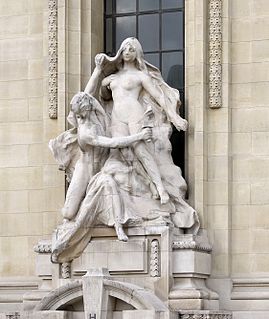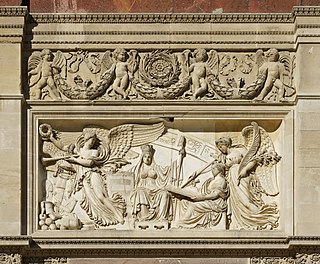
Edme Gaulle (1762, [1] Langres - January 1841, Paris) was a French sculptor.

Edme Gaulle (1762, [1] Langres - January 1841, Paris) was a French sculptor.
He began by studying drawing with Francois Devosge at the school in Dijon, then going to follow Jean Guillaume Moitte's course at the École des Beaux-Arts in Paris. He won the second prize for sculpture in 1791 with Pericles coming to visit Anaxagoras , and the first prize for sculpture (Prix de Rome) in 1803 for Ulysses recognising his nurse Eurycleia , but the Napoleonic Wars prevented him setting out for Rome for his stay at the Villa Medici. He and François Rude were two of the thirty sculptors charged with the sculpture of the colonne de la Grande Armée on place Vendôme in Paris.
He was an expert consultant on the restoration of the bas-relief of the pediment of the Panthéon de Paris, realised by David d'Angers in 1830. This pediment was originally sculpted by his master Moitte in 1793 and was practically destroyed in 1822, with Edme Gaulle succeeding in conserving the fragments that were left. He had made several sketches of the pediment before its destruction, but had been unable to prevent it. In 1831, he was made inspecteur conservateur of the Dépôt des marbres of the Ministry of Public Works, on île des cygnes, founded by Colbert.

The Panthéon is a monument in the 5th arrondissement of Paris, France. It stands in the Latin Quarter, atop the Montagne Sainte-Geneviève, in the centre of the Place du Panthéon, which was named after it. The edifice was built between 1758 and 1790, from designs by Jacques-Germain Soufflot, at the behest of King Louis XV of France; the king intended it as a church dedicated to Saint Genevieve, Paris' patron saint, whose relics were to be housed in the church. Neither Soufflot nor Louis XV lived to see the church completed.

L'église de la Madeleine is a Catholic church occupying a commanding position in the 8th arrondissement of Paris. The Madeleine Church was originally supposed to be built as a Catholic church, but the building was unfinished as a result of the Revolution. Napoleon finished constructing the building as a memorial dedicated to his army, but after the Restoration it was converted into a Catholic church named after Saint Mary Magdalene. To its south lies the Place de la Concorde, to the east is the Place Vendôme, and to the west Saint-Augustin, Paris.

The Arc de Triomphe du Carrousel is a triumphal arch in Paris, located in the Place du Carrousel. It is an example of Neoclassical architecture in the Corinthian order. It was built between 1806 and 1808 to commemorate Napoleon's military victories in the Wars of the Third and Fourth Coalitions. The Arc de Triomphe de l'Étoile, at the far end of the Champs Élysées, was designed in the same year; it is about twice the size and was not completed until 1836.

Baron François Joseph Bosio was a Monegasque sculptor who achieved distinction in the first quarter of the nineteenth century with his work for Napoleon and for the restored French monarchy.

Edmé Bouchardon was a French sculptor best known for his neoclassical statues in the gardens of the Palace of Versailles, his medals, his equestrian statue of Louis XV of France for the Place de la Concorde ; and for the Fountain of Four Seasons in Paris. He was also a draftsman and painter, and made celebrated series of engravings of working-class Parisians.

Pierre Cartellier was a French sculptor.

The Louis XV style or Louis Quinze is a style of architecture and decorative arts which appeared during the reign of Louis XV. From 1710 until about 1730, a period known as the Régence, it was largely an extension of the Louis XIV style of his great-grandfather and predecessor, Louis XIV. From about 1730 until about 1750, it became more original, decorative and exuberant, in what was known as the Rocaille style, under the influence of the King's mistress, Madame de Pompadour. It marked the beginning of the European Rococo movement. From 1750 until the King's death in 1774, it became more sober, ordered, and began to show the influences of Neoclassicism.

Étienne Le Hongre was a French sculptor, part of the team that worked for the Bâtiments du Roi at Versailles. Le Hongre was one of the first generation of sculptors formed by the precepts of the Académie royale de peinture et de sculpture. At the Bain des Nymphes (1678–80) he was one of the sculptors providing lead bas-reliefs for the fountain setting that featured the work of François Girardon. Le Hongre provided other bronze figures for the Parterre d'Eau.

Charles-François Lebœuf, called Nanteuil was a French sculptor.

Paul Jean-Baptiste Gasq was a French sculptor, born in Dijon.

Jean-Guillaume Moitte was a French sculptor.

The Fontaine des Innocents is a monumental public fountain located on the place Joachim-du-Bellay in the Les Halles district in the 1st arrondissement of Paris, France. Originally called the Fountain of the Nymphs, it was constructed between 1547 and 1550 by architect Pierre Lescot and sculptor Jean Goujon in the new style of the French Renaissance. It is the oldest monumental fountain in Paris.

The Fountains in Paris originally provided drinking water for city residents, and now are decorative features in the city's squares and parks. Paris has more than two hundred fountains, the oldest dating back to the 16th century. It also has more than one hundred Wallace drinking fountains. Most of the fountains are the property of the municipality.

The Fontaine des Quatre-Saisons is a monumental 18th-century public fountain, at 57-59 rue de Grenelle in the 7th arrondissement of Paris, France. It was executed by Edme Bouchardon, royal sculptor of King Louis XV, and opened in 1745. The fountain is huge and richly decorated, but it had only two water spouts, and its grand scale on the narrow street, together with the lack of water, irritated Voltaire and other figures of the French Enlightenment.

Jean Beausire was an architect, engineer and fountain-maker and the chief of public works in Paris for King Louis XIV of France and King Louis XV of France between 1684 and 1740, and was the architect of all the public fountains constructed in Paris that period. Several of his fountains still exist and continue to work. Three streets in the 4th arrondissement of Paris today carry his name: Rue Jean-Beausire, Impasse Jean-Beausire, and Passage Jean-Beausire.

The Fontaine de Léda, also sometimes referred to as the Fontaine du Regard, is a Parisian sculptural wall fountain built in 1806–1808 during the reign of Napoleon Bonaparte. The fountain depicts the legend of Leda and the Swan, with a central bas-relief panel by Achille Valois. It was originally located at the corner of the rue de Vaugirard and rue du Regard, hence the alternative name; however, in 1864, during the reconstruction of Paris by Emperor Louis Napoleon, the fountain was moved to the back side of the Medici Fountain in the Luxembourg Garden, where it remains.

Jacques-Philippe Le Sueur (1759–1830), was a French sculptor.

Nicolas-Sébastien Adam, also called "Adam the Younger", was a French sculptor working in the Neoclassical style. He was born in Nancy and died in Paris.
Eudes de Montreuil was a 13th-century French master builder, sculptor and combat engineer. He may have died in 1289.